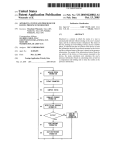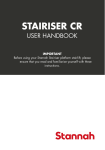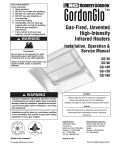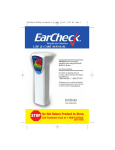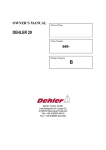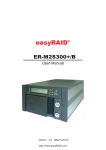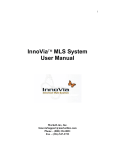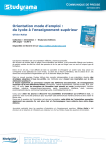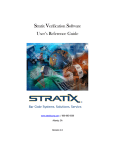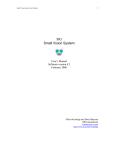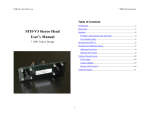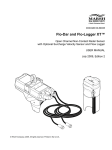Download Apparatus and method for engaging acoustic vibration sensors to skin
Transcript
US008474338B2 (12) United States Patent (10) Patent No.: Gelman et a]. (54) US 8,474,338 B2 (45) Date of Patent: APPARATUS AND METHOD FOR ENGAGING (56) Jul. 2, 2013 References Cited ACOUSTIC VIBRATION SENSORS TO SKIN US. PATENT DOCUMENTS (75) Inventors: Gregory Gelman, Rehovot (IL); Guy Ben-Ezra, Karkur (IL) 2002/0183642 A1* 2003/0045806 A1* (73) Assignee: Deep Breeze Ltd., Orakiva (IL) 2009/0093687 A1* 2010/0256512 A1* 12/2002 3/2003 Murphy ...................... .. 600/532 Brydon .... .. 600/534 2004/0236239 A1* 11/2004 Murray et al. (*) Notice: Subject to any disclaimer, the term of this patent is extended or adjusted under 35 4/2009 10/2010 600/528 Telfort et a1. .... .. 600/300 Sullivan ...................... .. 600/529 FOREIGN PATENT DOCUMENTS W0 U.S.C. 154(b) by 372 days. WO 2009083942 A1 * 7/2009 OTHER PUBLICATIONS (21) App1.No.: 12/s05,0s2 Kraman, “Comparison of lung sound transducers using a biacousitic (22) Filed: transducer testing system”, 2006, American Pphysiological Society, JAppl Physiol 101, 469-476.* Jul. 12, 2010 (65) Prior Publication Data US 2011/0005320 A1 * cited by examiner Jan. 13, 2011 Related US. Application Data (60) Provisional application No. 61/224,947, ?led on Jul. 13, 2009. (51) Int. Cl. G01D 21/00 G01D 11/30 US. Cl. Primary Examiner * Peter Macchiarolo Assistant Examiner * Tamiko Bellamy (57) (52) A system comprising a viscoelastic interface sheet to engage (2006.01) (2006.01) a sound vibrations sensors array to a sound generating objects. The structure of the interface sheet includes elements for easy handling, positioning and mounting. A device for storage and mounting support of such interface sheets is CPC .................................... .. G01D 11/30 (2013.01) USPC (58) ....................................................... .. ABSTRACT 73/8665 disclosed. Field of Classi?cation Search USPC ................ .. 600/528, 538, 533; 73/8665, 529 See application ?le for complete search history. 5 Claims, 10 Drawing Sheets 103 301 US. Patent Jul. 2, 2013 Sheet 1 0f 10 103 Figure 1 US 8,474,338 B2 US. Patent Jul. 2, 2013 Sheet 2 0f 10 \in mon I I. . Figure 2 US 8,474,338 B2 US. Patent Jul. 2, 2013 Sheet 3 0f 10 US 8,474,338 B2 103 101 302 ._ 105 303 102 301 Figure 3 US. Patent Jul. 2, 2013 Sheet 4 0f 10 US 8,474,338 B2 102 Figure 4 US. Patent Jul. 2, 2013 Sheet 5 0f 10 US 8,474,338 B2 504 102 505 502 a?I’ Figure 5 US. Patent Jul. 2, 2013 102 Sheet 6 0f 10 US 8,474,338 B2 / 602 401 601 402 Figure 6 US. Patent Jul. 2, 2013 Sheet 7 0f 10 705 102 US 8,474,338 B2 US. Patent Jul. 2, 2013 Sheet 8 0f 10 Figure 8 US 8,474,338 B2 US. Patent Jul. 2, 2013 Sheet 9 0f 10 US 8,474,338 B2 901 ‘llllll[lllllllllllllllllillllIllllllllllllll\llIllllllllllllllllllllllllllllllllllllllllnm|m||||n||||| Figure 9 l|lll|||| "III II Hll lllll' US. Patent Jul. 2, 2013 Sheet 10 0f 10 US 8,474,338 B2 1001 102 Figure 10 401 /@9@@@ @@ Q 102 Figure 11 402 US 8,474,338 B2 1 2 APPARATUS AND METHOD FOR ENGAGING ACOUSTIC VIBRATION SENSORS TO SKIN This gel replaces the air layer betWeen the SGO and the SVS and reduces the acoustic re?ection in the surfaces betWeen the different materials. These kinds of gel, provided in a form of paste, are incon venient to use for three main reasons, explained in reference to the VRIxp: l. The gel does not provide engagement characteristics to hold the SGO and the SVS together during the acoustic moni CROSS-REFERENCE TO RELATED PATENT APPLICATIONS This patent application claims priority from and is related to US. Provisional Patent Application Ser. No. 61/224,947, ?led 13 Jul. 2009, this US. Provisional Patent Application toring process. When using the VRIxp this creates a major inconvenience to the operator and might result in loW quality incorporated by reference in its entirety herein. accosting signal recording. 2. When the acoustic signal acquisition is completed, the FIELD OF THE INVENTION gel needs to be Wiped off the patient and the SVS. This causes inconvenience to the patient and additional Work load to the The invention is related to the ?eld of acoustic vibration operator of the RVIxp. monitoring and recording, and more particularly, to the 3. Remainders of gel might function as contamination car engagement of acoustic vibration sensors to different objects, including human body skin for medical uses. BACKGROUND OF THE INVENTION 20 Acoustical sensors are attached to objects generating sound in various Ways. Simple stethoscopes are hand-held against the skin of the patient using hand-force of the physi cian. The VRIxp, an acoustic vibrations recorder manufactured by Deep Breeze Ltd., OrAkiva, Israel, uses vacuum suction to 25 attach and hold an array of sensors to human skin. This generating object, particularly to human tissue. These meth ods and tools provide considerable improvements for the three main issues associated With gel: (1) Engagement mechanism (2) Need for Wiping off the gel (3) Risk of cross contamination. The present invention also provides an e?i method has the folloWing disadvantages: Issues With adhering to hairy skin due to vacuum leaks riers, carrying contamination from one patient to another. This requires disinfection of the SVS prior to usage With another patient, Which creates yet additional load on the operator and still holds the risk of imperfect disinfection and cross-contamination. It is the purpose of the present invention to provide meth ods and tools to improve the engagement of SVS to sound cient Work?oW for setting up acoustic monitoring. 30 SUMMARY OF THE INVENTION Limited duration in Which the sensors can remain on the skin due to potential hematoma Requires a vacuum pump of a certain siZe and electrical needs in order to produce the required vacuum level. The vacuum pump creates noise during operation 35 Leaks near the sensors location may create arti?cial noise Which may affect the recorded sounds The vacuum system in Whole is exposed to leaks Which may reduce the adherence strength Detachment and re-attachment of sensors during the breathing cycle due to changes in vacuum levels may simulate false pathological sounds such as crackles interface provides the acoustic matching interface by replac ing the air gap betWeen the SVS and the SGO, it provides the 40 engagement mechanism through the glue coated surfaces, it requires no cleaning after useiit is simply peeled off the SGO and the SVS and it functions as a contamination barrier. The invention Will be described With reference to recording (rales) The overall cost of a vacuum system is high The user is required to oversee that the vacuum system is in In one embodiment of the present invention, an interface made of a soft layer of material is introduced betWeen the SVS and the SGO. This interface is coated With glue on both sides, that adheres Well to the surface of the soft material and provides loWer adhesion force to the SVS and the SGO. This 45 sounds from human respiratory activity, in medical use, using the VRIxp. This description is provided as an example and does not limit the scope of the invention to the described good performance during operation system and objects. Other methods of adhering an array of sensors to the skin and having certain limitations may include: UtiliZation of body Weight laying over the sensors toWard BRIEF DESCRIPTION OF THE DRAWINGS 50 The invention Will be better understood in reference to the gravity A belt or a vest Which is Wrapped around the patients and presses the sensors to the skin. A main issue of acoustic transmission betWeen sound folloWing Figures: vibration sensors (SVS) and sound generating object (SGO) present invention; is related to the passage of acoustic Waves from the SGO to FIG. 1 is an illustration of the main elements involved in the 55 FIG. 2 illustrates a general mode of using the interface With the SVS through an air layer. The difference in the three the SVS for respiratory monitoring; materials involved results in re?ection and scatters of acous FIG. 3 demonstrates hoW the properties of the interface function to replace the air gap and provide the engagement force betWeen the SVS and the patient; tic energy, causing loss of energy and echoes, resulting in poor acoustic detection quality. To overcome this problem, materials of the SVS are designed to have similar acoustic properties as the SGO. To overcome the air layer betWeen the SGO and the SVS, an acoustic matching interface is com 60 FIGS. 5A through 5B discloses an additional embodiment monly used. One such common example is ultrasound imag of the interface of the present invention; ing in medical applications. The impedance matching mate rial is a paste commonly knoWn as ultrasound gel, such as ParkerAquasonic® 100 Ultrasound Transmission Gel, manu factured by Parker Laboratories, Inc. of Fair?eld, N.J., USA. FIGS. 4A and 4B disclose tWo embodiments of the inter face of the present invention; FIG. 6 discloses an additional embodiment of the interface 65 of the present invention; FIGS. 7A through 7C disclose an additional embodiment of the interface of the present invention; US 8,474,338 B2 4 3 FIGS. 8A through 8D discloses a tray holding a number of Reference is made noW to FIG. 4, disclosing another embodiment of the present invention. In FIG. 4A interface 102 is shoWn With tWo liners 401 and 402 covering the Whole area of the interface and optionally extending further if desired, typically up to 50 mm. TWo separators 403 and 404 cover the Whole Width of the interface interfaces and provides also positioning and placement sup port mechanism; FIGS. 9A through 9D discloses an additional embodiment of the interface of the present invention Where RFID or bar code are incorporated to prevent re-use of the interface to avoid cross-contamination potential of multiple uses of the (perpendicular to the draWing surface) but only a fraction of interface; its length, such as 10-20 mm from the edge and extend typi FIG. 10 discloses an additional embodiment of the inter cally 0-30 mm from the edge of the interface. This is a con face of the present invention, including positioning marks; ?guration of the interface arranged for handling and storage and FIG. 11 discloses an additional embodiment of the inter face of the present invention, Wherein each SVS receives a prior to application to an SVS array. Liners 401 and 402 cover the glue coated surface of interface 102 to alloW for holding DETAILED DESCRIPTION OF THE INVENTION by hand and placing on a table or a package Without interfer ing With the glue on the interface surface. To mount the interface on an SVS array, the user ?rst holds together liner Reference is made noW to FIG. 1, Which is a general description of one embodiment of the system described in the 402 With separators 403 and 404 by one hand, and liner 401 by the other hand. By pulling the hands apart liner 401 is removed from the assembly of FIG. 4A and the glue layer of separate interface. context of the environment of respiration sounds recording from human patients, using the VRIxp. SVS array 101 is, for example, a set of l 0 pieZo-electric SVS units 105, arranged on a rectangular grid of 2x5 as shoWn by numerical reference 106. Such arrays, the Way they are used, the connection to a computer and the complete environment are disclosed in 20 25 this side of the interface is exposed. The interface can noW be attached to the SVS array With the exposed surface. In the next step the user holds together separators 403 and 404 and the SVS array by one hand and liner 402 by the other hand. The user can then peel-off liner 402 While interface 102 stays attached to the SVS array. The result is assembly 201 of FIG. details in the VRIxp product user manual, incorporated herein by reference, and on the Website of Deep Breeze (WWW.deep 2, ready for placement on exposed back 103. breZe.com). except that separator 403 is not a part of the assembly. The mounting procedure of the embodiment of FIG. 4B is the same as the mounting procedure of FIG. 4A except for miss Interface 102 is a sheet of viscoelastic material coated With ?exible adhesive material on both sides. The material is FIG. 4B discloses an embodiment similar to FIG. 4A 30 selected to provide loW-stress displacement characteristics. One such example is No. 9880 3M Hydrogel Adhesive Tape distributed by 3M Health Care, St. Paul, Minn., USA. The layer of ?exible adhesive material may further comprise an acoustic impedance matching layer. ing separator 403. In this embodiment, the single separator 404 might require improved strength contact to interface 102 since it experiences higher load than in the embodiment of 35 Numerical reference 103 refers to an exposed human back FIG. 4A. Liners 401 and 402 can be cut of different typical materials for such use. One such example is RayoWebTM CR50, manu ready for placement of the SVS array. factured by Innovia Films Ltd. Tecumseh, Kans., USA. Placement of the SVS array is generally made in tWo steps. In the ?rst step the SVS array 101 and the interface 102 are Separators 403 and 404 can be cut of different typical materials for such use. One such example is plain paper. moved into contact (arroW 104) and pressed against each 40 other to provide the assembly 201 of FIG. 2. With reference to FIG. 2, assembly 201 is moved noW in direction 202 to be attached to the exposed back 103. This provides the complete assembly ready for respiratory acoustic monitoring. It Would be appreciated that the order of placing the interface 102 on the SVS array 101 or the exposed back 103 is not limiting and 45 can be reversed. edge 503 of the liner together With separator 404 by one hand and holding the right edge 502 of the liner by the other hand. Then the right side of the liner is peeled off interface 102 and rotated anticlock Wise to position 505 of FIG. 5B. The user Reference is made noW to FIG. 3, Which provides a side vieW of the complete assembly. Both the interface 102 and the SVS array 101 need to generally folloW the exposed back curvature indicated by numerical reference 301. The SVS Reference is made noW to FIG. 5 disclosing an additional embodiment of the present invention. In FIG. 5A liners 401 and 402 of FIG. 4 are replaced by a single liner 501 covering interface 102 on both sides. The application of this embodi ment onto the SVS array starts With holding together the left can noW hold the assembly Without tampering With the glue 50 surface by holding by one hand the loWer part including liner edge 503 and separator 404 and by the other hand the top part array 101 has a limited ?exibility and each SVS 105 has ?at 504 of the liner. The interface can noW be applied to and surfaces. This prevents the SVS array 101 from completely pressed against the SVS array to provide assembly 201 of folloW the back curvature 301. As a result, considerable air gaps might be introduced betWeen some of the SVS 105 and FIG. 2. To mount assembly 201 onto exposed back 103, liner 55 the exposed back surface 301, resulting in poor acoustic transmission. Interface 102 is shoWn in FIG. 3 to be adhered to both SVS array 101 and exposed back surface 103. Also, the viscoelas tic characteristics of the interface are shoWn Where the inter 60 face easily gives Way for loW-stress increased thickness (3 02) and loW-stress reduced thickness (303). This alloWs a rela tively loW adhesion glue to be able to hold the assembly in place, alloWs for relatively easy disassembly of the assembled SVS array 101, interface 102 and patient 103, and also enables e?icient removal of air gaps betWeen each SVS 105 and the exposed back 103. 65 501 is removed by holding separator 404 against the SVS array by one hand and peeling-off the liner by the other hand, pulling aWay edge 503 of the liner. Reference is made noW to FIG. 6, disclosing another embodiment of the invention. In this embodiment liner 401 is lifted from interface 102 to expose surface section 601 of the liner Which is free of glue. This is another implementation of the function of separating liners 401 and 402. Since section 601 is clear of glue, it is very easy to separate it from liner 401. As such, section 601 and its parallel section on the other side of the interface (not shoWn) can assume the function of sepa rators 403 and 404 in the procedure of mounting the interface on SVS array 101 and exposed back 103. US 8,474,338 B2 6 5 It Will be appreciated by those skilled in the art that addi tional solutions are possible, such as coating section 601 With In the next step, described in reference to FIG. 8D, guides 804 are rotated to clear the Way for removal of the interface non-sticking paint over the glue, and that the speci?c descrip and SVS array assembly. Liner 402 is removed as shoWn by illustrative arroW 808 and the assembly is ready for handling for attachment to exposed back 103. It Would be appreciated that the storage device can be used tion of the various embodiments does not limit the scope of the invention. In addition, edge 602 of section 601 may be marked by various methods. One such method is printing a line on the liner or on the interface at the position of edge 602. Also usage of colored glue for the liner can be used to provide the user With a visual indication of edge 602. This indication Will be used by the user for proper positioning of the interface on the With a specially designed cover to protect the interfaces from dust and dirt. Also, the storage device can be made out of loW cost materials such as cardboard and different polymers to reduce its cost to a level it can also be used as the packaging of a set of interfaces, for a single use for this set, being disposable after the interfaces set is exhausted. It Would also be appreciated that the device of FIG. 8 can SVS array, avoiding placement of area Without glue onto the SVS array surface. Reference is made noW to FIG. 7. In this embodiment of the invention separators are not required. In FIG. 7a, tWo separate liners cover each side of interface 102. Liners 702, 704 are folded back onto themselves as also be reduced for positioning function only of interfaces onto SVS array by removing the storage part on the left side of the device and replacing guide 804 by straight vertical pins shoWn, While liner 701, 703 overlaps liners 702, 704 respec tively, typically extending 5-20 mm beyond the edge of the ?rst liner. The ?rst step in applying the interface onto SVS array 101 20 located in registration to the SVS array. The alignment of the interface to the SVS array is made then by ?rst placing the array in the device, then removing liner 401 from an interface and then placing the interface, exposed glue side to the SVS is by holding the liner 701 generally Where numerical refer array, With the holes 802 on the pins to get the desired regis ence 701 points at and lifting it. Then liner 702 is held gen erally Where numerical reference 702 points at and lifted. Both liners 701 and 702 are removed from the interface, tration to the SVS array. Reference is made noW to FIG. 9, describing another 25 embodiment of the invention Where RFID (Radio Frequency exposing the right glue surface ready to be mounted onto SVS Identi?cation) or barcode are used to reduce the risk of cross array 102. Liners 703 and 704 are removed using the same process of contamination betWeen patients by ensuring a single use of removing liners 701 and 702. FIG. 7B discloses another con?guration Where liners 702 30 and 704 of FIG. 7A are made from a single liner 705, and similarly liners 701 and 703 are made from a single liner 708. Unique, part number 601116 manufactured by Cyntag, Inc., With this con?guration, When removing the liners from the right surface of the interface (in the same process of FIG. 7A), the liners are not detached from the assembly but are folded back to the left side as shoWn in FIG. 7C. At this stage the user 35 the RFID read/Write module is installed in SVS array 101 as shoWn in FIG. 9C. The RFID reader/Writer is not shoWn in the 40 draWing. When the interface is mounted in the SVS array, the RFID tag 901 is positioned near the RFID antenna 902. The reader then reads the RFID tag and transfers the data to the computer Reference is made noW to FIG. 8 describing a storage device for multiple interfaces 102 and a mechanism for con venient positioning and mounting of interface 102 onto SVS array 101. Interface assembly 801 shoWn in FIG. 8A is gen erally the same as the one of FIG. 4B With the addition of tWo Cynthiana, Ky., USA. Also RFID tag reader/Writers are Widely available, one such example is 125 KHZ Q5 RFID Reader/Writer also manufactured by Cyntag, Inc ., Cynthiana, Ky., USA. In one embodiment of the invention, the RFID tag is installed in the interface assembly While the antenna 902 of can hold the assembly by the liner at the upper end 706 and by the liner at the loWer end 707. This enables the attachment of the exposed right surface of the interface onto the SVS array 101 Without tampering With the glue surface of interface 102. each interface. FIG. 9A illustrates generally the same interface assembly as in FIG. 5A, With an added RFID tag 901. Many RFID tags are available in the market, one example is 125 KHZ CD20 of the VRIxp (not shoWn in the draWing). The computer 45 veri?es the tag has not been used before. If the data of the holes 802 and tWo cut-offs 803 in liner 401, to enable removal RFID tag indicates previous usage, the computer system ofliner 401 While a ?-shaped guide 804 (FIG. 8B) is in hole declines the process With a proper message to the user such as 802. FIG. 8B presents ?ve interfaces stored on the left side of With another patient. Please replace interface and try again”. storage device 805. The length of interface 102 is perpendicu lar to the plane of FIG. 8. TWo guides 804 go through the tWo holes 802 of the interfaces, holding them in place one on top of the other. On the right hand side of storage device 805 a SVS array 101 is positioned, in registration, by design, to guides 804. “acquisition cannot be started: the interface has been used 50 55 To mount the top-most interface on SVS array 101 the user ?rst peels-off liner 401 as shoWn by arroW 806. It is appreci ated that arroW 806 does not represent the actual direction of peeling liner 401 but is only used to illustrate the concept of peeling. In the next step, illustrated in FIG. 8C, the user ?ips over the interface by rotating it clockWise, as shoWn by arroW 807 until the interface rests upon the SVS array surface. Holes 60 carry an ID number. A given VRIxp machine Would accumu late an ID list of all interfaces used in this machine. For each neW interface the computer Will check if the ID number of this interface is in the used-list or not. If it is, it Will decline the 65 continuation of the acquisition process. If it is not in the list, the acquisition With this interface Will be alloWed. In yet another implementation of the RFID system of FIGS. 9A and 9B, and the barcode 903 of FIG. 9D, the reading/Writing of the information of the RFID tag or the 802 in the interface, guides 804 and registration of SVS array to the guides ensure that the interface is positioned With proper registration on the surface of the SVS array. The inter face is noW pressed by the user onto the surface of the SVS array to ensure proper adhesion. If, hoWever, the data indicates an unused interface, the computer instructs the RFID read/Write module to change the data in the tag to indicate “used status” and the acquisition process continues. It Would be appreciated by those skilled in the art that this contamination barrier method using RFID can be imple mented in additional Ways. For example, each RFID tag may barcode may be disassociated from SVS array 101. In this embodiment the readers are separate from the SVS array and US 8,474,338 B2 7 8 the communication With the RFID tag or the barcode is typi cally made before attaching the interface to the SVS array. It Would appreciated that the barcode method may include the method mentioned above of generating a list of used interfaces and comparing each neW interface to this list by the In yet another embodiment of the invention, a consider ation of children being more sensitive to pulling-off the inter face from their skin is made to modify the glue placed on the surfaces of interface 102. In such a case, the side of the interface that contacts the skin of the children is coated With glue With loWer adhesive force than the side of the interface VRIxp computer. It is also possible to preload the VRIxp With a pre-set ID list of alloWed interfaces, for example, by using a facing the SVS array. With this arrangement, pulling off the interface from a child’ s skin results in a loWer irritation force “package barcode” mounted on a package of a set of inter due to the adjusted glue. faces. This barcode provides the VRIxp With a code enabling the VRIxp softWare to properly generate the ID list of the interfaces included in this package. NoW, When using an interface, the computer Will check if the barcode of the inter The hereinabove embodiments are described in a Way of example only and do not specify a limited the scope of the invention. The invention claimed is: 1. An interfacing assembly for interfacing an array of sound vibration sensors (SVS) to a sound generation object face matches one of the alloWed list. If it does, the relevant ID Will be marked “used” to disable additional usage of an inter face With the same number. (SGO) comprising: It Would be appreciated that the locations of the RFID tags (embedded in the interface bulk) and barcode as shoWn in a viscoelastic sheet; a ?exible adhesive coating on each side of said viscoelastic FIG. 9 are presented as examples and the invention is not sheet; limited to the speci?c examples. Reference is made noW to FIG. 10 illustrating positioning marks to help the user register the interface onto the SVS array. In this example interface 102 and liners 401 and 402 are transparent. Circles 1001 are printed on top of liner 402, these circles having the same geometry as the SVS in the SVS array 101. After the user removes liner 401, he brings the interface in close distance to SVS array 101 and visually aligns the printed circles With the SVS array visible through the inter 20 array of SVS and on the other side thereof to said SGO, Wherein said means for attaching comprise a liner on each side of said sheet; and at least one separator betWeen part of said sheet and said 25 face transparent layers. Once the printed circles and the SVS 30 It Would appreciated that the printing geometry is provided 35 acquisition is completed. for interfacing an array of sound vibration sensors (SVS) to a sound generation object (SGO), comprising pins assembled in registration to an SVS array bed and holes in the at least one substrates (such as interface 102 itself) are available. Reference is made noW to FIG. 11 illustrating an interface removing the assembly from their back, after respiratory data 3. The assembly of claim 1, Wherein said part of said sheet is clear of glue. 4. The assembly of claim 1 Wherein said part of the sheet is coated With non-sticking material. 5. A device for positioning at least one interface assembly here only as an example and other alignment geometries and exposed back 103 is included in the assembly. This method might be more convenient to sensitive skin patients When liner, for facilitating the peeling of said liner from said sheet. 2. The assembly of claim 1, Wherein said at least one separator comprises tWo separators, each on a respective side of said sheet. array geometry are aligned, the user brings the interface and the SVS array into contact and presses the surface of the interface to ensure adhesion to the SVS array. Then liner 402 can be removed for mounting the assembly on exposed back 103. cut in the shape of isolated circles. With this embodiment, only the interface area that actually binds the SVS to the means for attaching said sheet on one side thereof to said interface assembly in conjunction With said pins, such that placing the interface device on the pins registers the interface 40 device to the SVS array Which is in the SVS array bed; and a tray for holding the at least one interface assembly and guides to help guiding each said at least one interface assembly to the SVS array in proper registration. * * * * *















